How To Choose Trucks for Skateboards
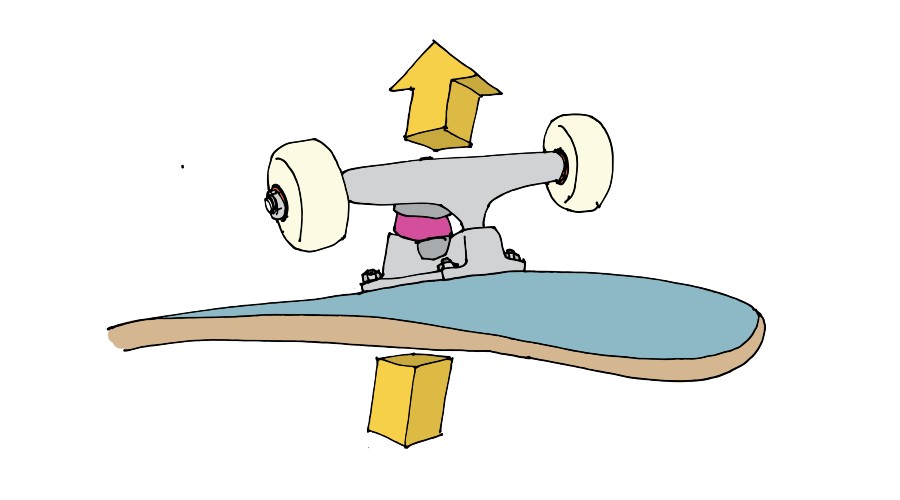
When choosing your skateboard trucks, there are several factors you need to consider. Making sure you pick the right size and height is crucial, as this makes all the difference to the feel and performance of your board.
The answer to the question “Are skateboard trucks universal?” is “No.”
While all trucks follow the same four hole attachment pattern, they come in a variety of axle sizes, heights, kingpin types.
Choosing the right trucks depends entirely on your skateboard deck and your riding style. Read on to learn about some of the differences.
What Are Trucks on a Skateboard?
Skateboard trucks are the T-shaped metal parts mounted onto the bottom of the deck which keep your wheels and bearings attached. Trucks consist of the following components:
- Axle: The part attached to the wheels; runs through the hanger.
- Hanger: Large triangular metal part with the axle running through it. Must be durable, as this part is subject to a lot of impact from grinds and other tricks.
- Kingpin: The bolt that holds all the parts together, located inside the bushings; the kingpin can be mounted in two directions, standard and reverse, which impacts the way the truck turns.
- Bushings: Round urethane rings surrounding the kingpin that work like a spring to transfer pressure and enable turning. The harder your bushings, the harder it is to turn.
- Baseplate: The flat metal part attached directly to the board; connects the kingpin and hanger to the board. Must be placed directly in the center to distribute your weight evenly.
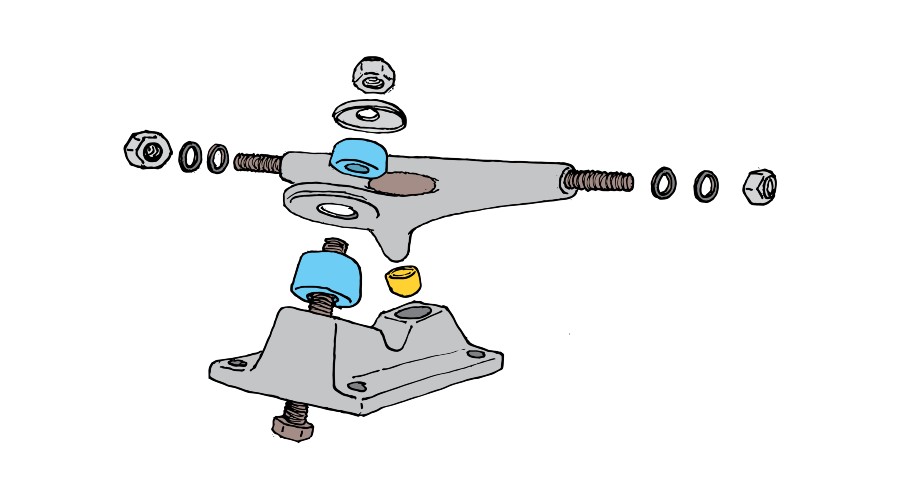
Types of Skateboard Trucks
There are two main types of skateboard trucks on the market: the most common type is the standard kingpin, followed by the reverse kingpin. Knowing which one to choose is important as they provide entirely different sensations in terms of stability and turning radius. Each type is explored in more detail below.
Standard Kingpin Skateboard Trucks
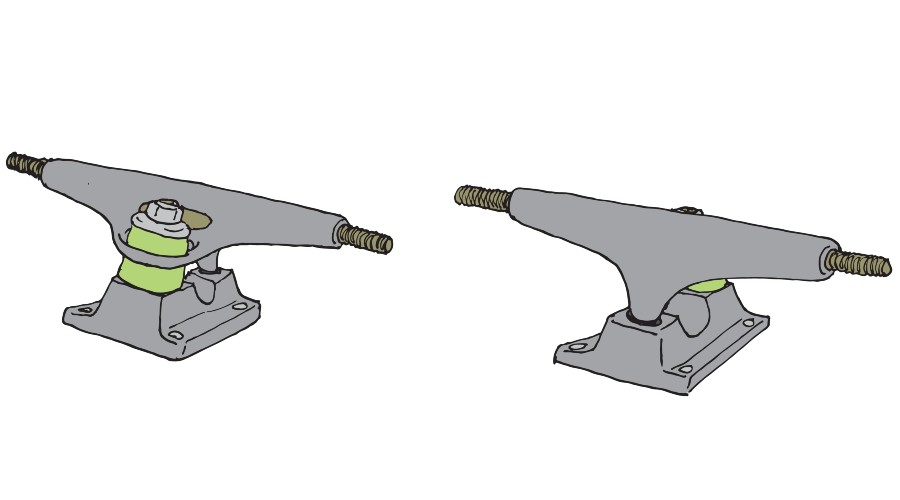
Standard kingpins sit higher and point toward the center of the deck; they are more rigid and provide greater stability when popping or landing tricks. You can change how rigid trucks are by installing softer bushings or adjusting the tightness of the kingpin. Standard kingpins are the go-to choice for traditional street skating.
Reverse Kingpin Skateboard Trucks
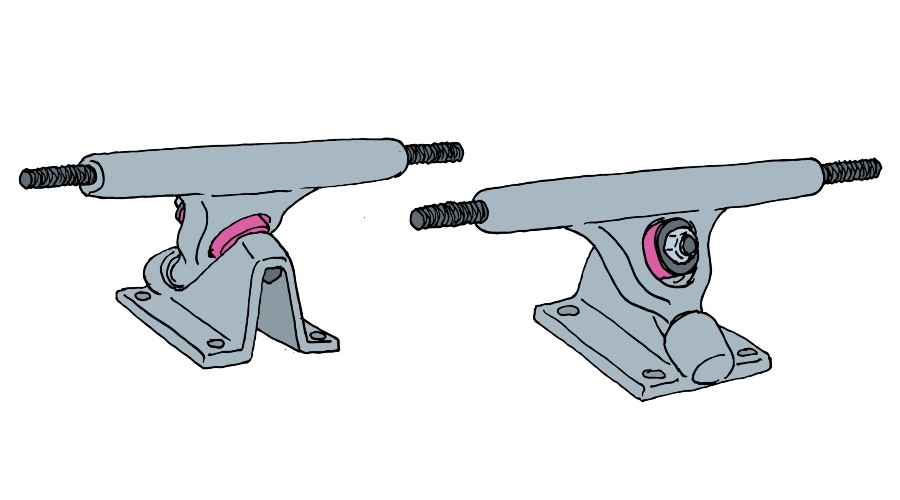
Reverse kingpins, on the other hand, sit lower and face away from the center of the board; they give a smoother response, making them the better choice for sharper turns. Reverse kingpins are therefore ideal for carving, surf-skating and downhill skating.
Hard vs. Soft Skateboard Bushings
Some skaters find harder bushings more suitable for tricks, as they are sturdier upon landing. Softer bushings are suitable for cruising or any kind of riding where you make sharp turns, such as bowl riding, as they are more responsive to the pressure applied to the deck from the feet.
Skateboard Truck Size Chart
You may be wondering whether to go for small trucks or large trucks, also referred to as narrow trucks or wide trucks. Larger/wider trucks provide greater stability, but are less responsive when turning than smaller/narrower trucks, which weigh less and are nimbler. In general, though, all you need to do is make sure your trucks are proportional to the width of your deck – yep, it’s that easy!
Since truck sizing varies across brands, we recommend checking the manufacturer’s suggestion for sizing depending on the skateboard, but the chart below is a good general guideline.
| Deck Size | Truck Size |
| 7.5” (190 mm) | 4.75” (120 mm) |
| 7.75” (197 mm) | 5.0” (127 mm) |
| 8.0” (203 mm) | 5.25” (133 mm) |
| 8.25–8.5” (210-216 mm) | 5.5” (140 mm) |
| 8.5”+ (216 mm+) | 6.15”+ (156 mm+) |
We cover more on our "How To Choose a Good Skateboard Deck" guide.
Skateboard Truck Height
Also known as truck profile, truck height refers to whether the truck sits low to the deck, high to the deck or in between. Choosing the correct truck height is important in making sure your wheels don’t touch your deck while turning and come to an abrupt stop, aka wheel bite.
While you might not need them with small wheels, you can install riser pads to keep slightly larger wheels away from the deck.
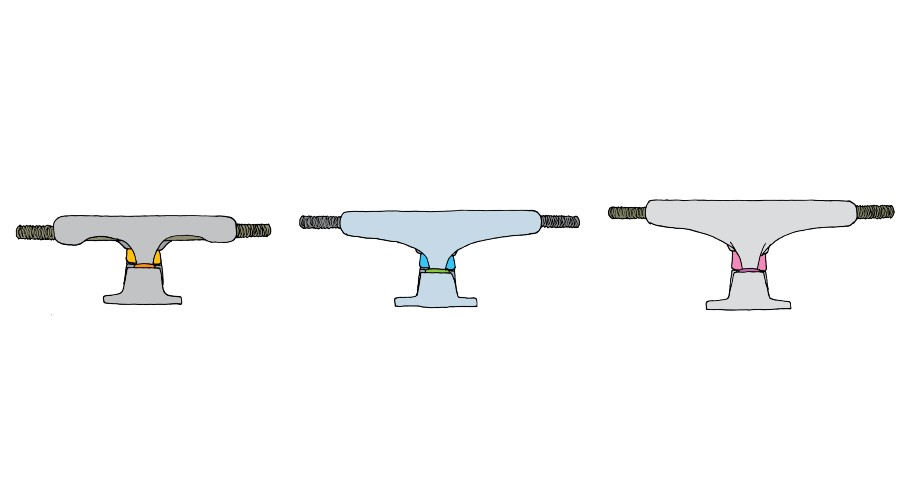
Low Trucks
Low trucks have less distance to the ground due to a shorter kingpin; this makes the trucks more stable and especially suitable for tricks, street skating and park skating. Low trucks should be paired with smaller wheels, under 55mm, to avoid wheel bite.
A lower skateboard truck will have:
- Greater stability
- Less potential turning radius – makes wider turns
- Greater likelihood of wheel bite
Mid Trucks
Mid trucks include some of the stability of lower trucks, but can be used with larger wheels, making them suitable for rough surfaces. These are a good choice if you plan to do a mix of cruising, park riding and street tricks.
High Trucks
High trucks have a longer distance to the ground due to a longer kingpin; great for carving and cruising. High trucks can accomodate bigger wheels and create sharper turns than the lower profiles. Riser pads can be added if you experience any wheel bite.
A taller skateboard truck will have:
- Lower stability
- Greater potential turning radius – makes tighter turns
- Less likelihood of wheelbite
Riser Pads and Wheel Bite
Depending on your skateboard deck, truck height, and axle length, you might want to consider adding riser pads to your set up.
What are riser pads? Riser pads increase the distance between your wheels and the skateboard deck, decreasing the risk of wheel bite and allowing for a tighter turning radius.
Note: If installing riser pads, you will need to change the length of your skate hardware to match the new height.
What is wheel bite? Wheel bite is the moment in a turn when your wheel touches the skateboard deck and abruptly stops rolling, sending your body forward.
To check for wheel bite potential, try the following check:
- Flip your skateboard upside down
- Push on the wheel to see if it touches the deck.
If your wheel touches the skateboard deck easily, consider:
- Tightening your kingpin to reduce turning radius
- Adding riser pads
- Using smaller wheels
Some cruisers and longboard decks have cutouts above the wheels to reduce the likelihood of wheel bite while accommodating lower trucks.
What To Look For in Trucks
The most important thing to look for in trucks is that they are the right size for your board. Trucks that are too wide or narrow will compromise your board’s performance.
Beyond choosing the right size, other factors to consider are:
- Construction materials which have a direct impact on durability, weight, and rebound. For example, hollow titanium trucks are lighter and more durable than standard aluminum trucks.
- Known brand names go a long way as unknown brands might use lower quality materials which break and wear more easily.
When Should Skateboard Trucks Be Replaced?
Knowing when to replace your trucks and how to keep them fully functional is crucial in order to prevent falls and keep your skateboard in a usable condition. Look out for any developing cracks, warping, bent axles or baseplate damage. If you notice these changes, it’s time for a new set.
Stability, control, and ensuring that wheel bite doesn’t stop you in your tracks are all determined by your choice of trucks.
Related Guides
How To Choose Your Skateboard Size
How To Choose Skateboard Bearings
How To Choose Skateboard Wheels
How To Choose Skateboard Grip Tape